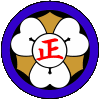Karate-gi (aka Keikō-gi)
 A
keikō-gi
("training clothes"), and in the case of
karate-do, specifically a karate-gi ("karate clothes") is
the fundamental item that participants in our karate classes
must acquire as soon as possible after enrolling in
class. The karate-gi consists of
three parts: the uwagi (jacket),
zubon (trousers), and obi (belt).
A
keikō-gi
("training clothes"), and in the case of
karate-do, specifically a karate-gi ("karate clothes") is
the fundamental item that participants in our karate classes
must acquire as soon as possible after enrolling in
class. The karate-gi consists of
three parts: the uwagi (jacket),
zubon (trousers), and obi (belt).
Although newcomers may participate in class for up to two months wearing normal, loose fitting workout clothing, a karate-gi is required for participation after that, and no participant is eligible for promotion in rank unless and until he or she has acquired a karate-gi conforming to AAU and Seishin-Kan standards.
AAU and Seishin-Kan
Karate-Gi Standards:
• The gi must be plain white, with no piping,
stripes, or other decorations. For children who are still growing, we recommend
acquiring a karate-gi that is one size too
large for the child and using seamstress tape or
tack-stitching to hem the sleeves and trouser legs until
the child grows into it. Otherwise, children tend
to outgrow their karate-gi long before the end of its useful life. The cost of a karate-gi can vary greatly according to
its size and quality. A lightweight karate-gi
suitable for beginners can be purchased new for $30.00
to $40.00 in most cases. We
recommend that beginners start with a lightweight gi, and
upgrade to a more durable heavyweight gi upon
reaching sankyū (3rd kyū) brown belt. Heavier-weight
karate-gi
that are better suited to long-term training or
tournament competition can range anywhere from about
$50.00 in children's sizes to over $200.00 for a
top-of-the-line gi for a large adult. Most adult
karate-ka can find a high quality, highly
durable karate-gi for about $75.00. Participants' karate-gi must be kept clean, in good
repair, and odor-free. Anyone with an excessively
dirty, damaged, or malodorous gi will be
prohibited
from class participation.
• If desired, a Seishin-Kan,
JKI, or AAU membership patch
may be affixed to the upper-left side of the uwagi
(jacket), approximately over the heart.
• The uwagi sleeves must extend to at least half
the length of the forearm, but not beyond the bend of
the wrist.
• The bottom of the uwagi must fully cover the
buttocks, but no more than three-quarters of the thigh.
• The zubon (trousers) must cover at least
two-thirds of the shins, but not extend below the ankle
bones.
• Neither the sleeves nor trouser legs may be rolled up
(must have a sewn or securely taped hem).
• The ends of the tied obi (belt) must hang at least 6
inches (15 cm) below the knot, but not lower than the
top of the knee.
• Female participants must wear an all-white t-shirt or
sports bra beneath the uwagi (jacket).



 Another
essential item of dōgu (equipment) is a pair of
kumite fist covers, which we usually call
kōgake ("gauntlets"), or
sometimes tekkō after the hand covers
worn by armoured samurai.
The type of kumite fist cover used in AAU
competition is NOT designed to protect either the
wearer's fist or the training partner's body from the
effects of a strike. Instead, the kumite
fist cover is a targeting aid, designed to provide an
accurate measure of correct striking distance during
training and competition.
Another
essential item of dōgu (equipment) is a pair of
kumite fist covers, which we usually call
kōgake ("gauntlets"), or
sometimes tekkō after the hand covers
worn by armoured samurai.
The type of kumite fist cover used in AAU
competition is NOT designed to protect either the
wearer's fist or the training partner's body from the
effects of a strike. Instead, the kumite
fist cover is a targeting aid, designed to provide an
accurate measure of correct striking distance during
training and competition.
